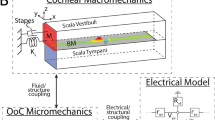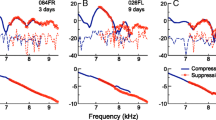Abstract
It is controversially discussed inasmuch acute hearing disorders might originate from impaired cochlear circulation. Hypoxia-specific alterations of inner ear parameters measurable in patients with acute sensorineural hearing loss would therefore be of great interest. Aim of this study was to characterize hypoxia-related alterations of the 2f 1−f 2 distortion product. Nine guinea pigs were anaesthetized by i.m. administration of Midazolam, Medetomidin and Fentanyl. For introduction of hypoxia, the spontaneously breathing animals were offered a gas mixture of N2O and O2 containing either 21 or 12–13% O2. Distortion product otoacoustic emissions (DPOAEs) were continuously monitored at f 2 = 16 kHz; f 2/f 1 = 1, 2; DP-definition = 2f 1−f 2; L 1 = 65 dB and L 2 = 55 dB, while inhaled oxygen was switched from 21 to 12–13% and back. Oxygen saturation (SaO2) was continuously monitored. Data from an hypoxic interval were only used for further data processing if DPOAE levels were stable before and after hypoxia. Six hypoxic intervals in five animals fulfilled the stability criterion. During the hypoxic interval with the highest measured SaO2 (75%), no alterations of DPOAE levels were observed. During the remaining five hypoxic intervals, when SaO2 ranged between 57 and 70%, DPOAE levels were on average lower with an increased standard deviation compared to mean pre-hypoxic levels. Mean decrease correlated with the decrease of SaO2 (r = 0.90, P = 0.014). Alterations followed a characteristic time course—when hypoxia was started, DPOAE levels exhibited a short increase before they decreased and remarkably destabilized. After re-oxygenation DPOAE levels showed a pronounced level decrease, while SaO2 already had recovered to pre-hypoxic values. After reaching a minimum, DPOAE levels slowly recovered to pre-hypoxic values. The decrease of DPOAE levels during hypoxia and the post-hypoxic level alterations have similarly been described by other authors before, while the distinct destabilization and transiently increased DPOAE levels have not been explicitly mentioned. A micromechanical mechanism that might explain a transient level increase and the post-hypoxic DPOAE level changes is discussed.



Similar content being viewed by others
References
Dallos P (1992) The active cochlea. J Neurosci 12:4575–4585
Dallos P, Evans BN (1995) High-frequency motility of outer hair cells and the cochlear amplifier. Science 267:2006–2009
Frank G, Kossl M (1996) The acoustic two-tone distortions 2f 1−f 2 and f 2−f 1 and their possible relation to changes in the operating point of the cochlear amplifier. Hear Res 98:104–115
Freeman S, Goitein K, Attias J, Furst M, Sohmer H (1995) Effect of hypoxemia and ethacrynic acid on ABR and distortion product emission thresholds. J Neurol Sci 131:21–29
Kirk DL, Patuzzi RB (1997) Transient changes in cochlear potentials and DPOAEs after low-frequency tones: the ‘two-minute bounce’ revisited. Hear Res 112:49–68
Kirk DL, Moleirinho A, Patuzzi RB (1997) Microphonic and DPOAE measurements suggest a micromechanical mechanism for the ‘bounce’ phenomenon following low-frequency tones. Hear Res 112:69–86
Lawrence M, Nuttall AL, Burgio PA (1977) Oxygen reserve and autoregulation in the cochlea. Acta Otolaryngol 83:146–152
Mazurek B, Haupt H, Georgiewa P, Klapp BF, Reisshauer A (2006) A model of peripherally developing hearing loss and tinnitus based on the role of hypoxia and ischemia. Med Hypotheses 67:892–899
Mees K, Behnisch A, Suckfull M (2003) [Audimont—a scientific research expedition to Mount Cho Oyu in the himalayas]. Fortschr Med Orig 121:1–4
Merchant SN, Adams JC, Nadol JB Jr (2005) Pathology and pathophysiology of idiopathic sudden sensorineural hearing loss. Otol Neurotol 26:151–160
Mom T, Avan P, Romand R, Gilain L (1997) Monitoring of functional changes after transient ischemia in gerbil cochlea. Brain Res 751:20–30
Mom T, Telischi FF, Martin GK, Lonsbury-Martin BL (1999) Measuring the cochlear blood flow and distortion-product otoacoustic emissions during reversible cochlear ischemia: a rabbit model. Hear Res 133:40–52
Olzowy B, von Gleichenstein G, Canis M, Mees K (2008) Distortion product otoacoustic emissions for assessment of intracranial hypertension at extreme altitude? Eur J Appl Physiol 103:19–23
Rebillard G, Lavigne-Rebillard M (1992) Effect of reversible hypoxia on the compared time courses of endocochlear potential and 2f 1−f 2 distortion products. Hear Res 62:142–148
Rebillard G, Klis JF, Lavigne-Rebillard M, Devaux P, Puel JL, Pujol R (1993) Changes in 2f 1−f 2 distortion product otoacoustic emissions following alterations of cochlear metabolism. Br J Audiol 27:117–121
Sawada S, Mori N, Mount RJ, Harrison RV (2001) Differential vulnerability of inner and outer hair cell systems to chronic mild hypoxia and glutamate ototoxicity: insights into the cause of auditory neuropathy. J Otolaryngol 30:106–114
Schrott A, Puel JL, Rebillard G (1991) Cochlear origin of 2f 1−f 2 distortion products assessed by using 2 types of mutant mice. Hear Res 52:245–253
Author information
Authors and Affiliations
Corresponding author
Rights and permissions
About this article
Cite this article
Olzowy, B., von Gleichenstein, G., Canis, M. et al. Complex level alterations of the 2f 1−f 2 distortion product due to hypoxia in the guinea pig. Eur Arch Otorhinolaryngol 265, 1329–1333 (2008). https://doi.org/10.1007/s00405-008-0663-3
Received:
Accepted:
Published:
Issue Date:
DOI: https://doi.org/10.1007/s00405-008-0663-3




